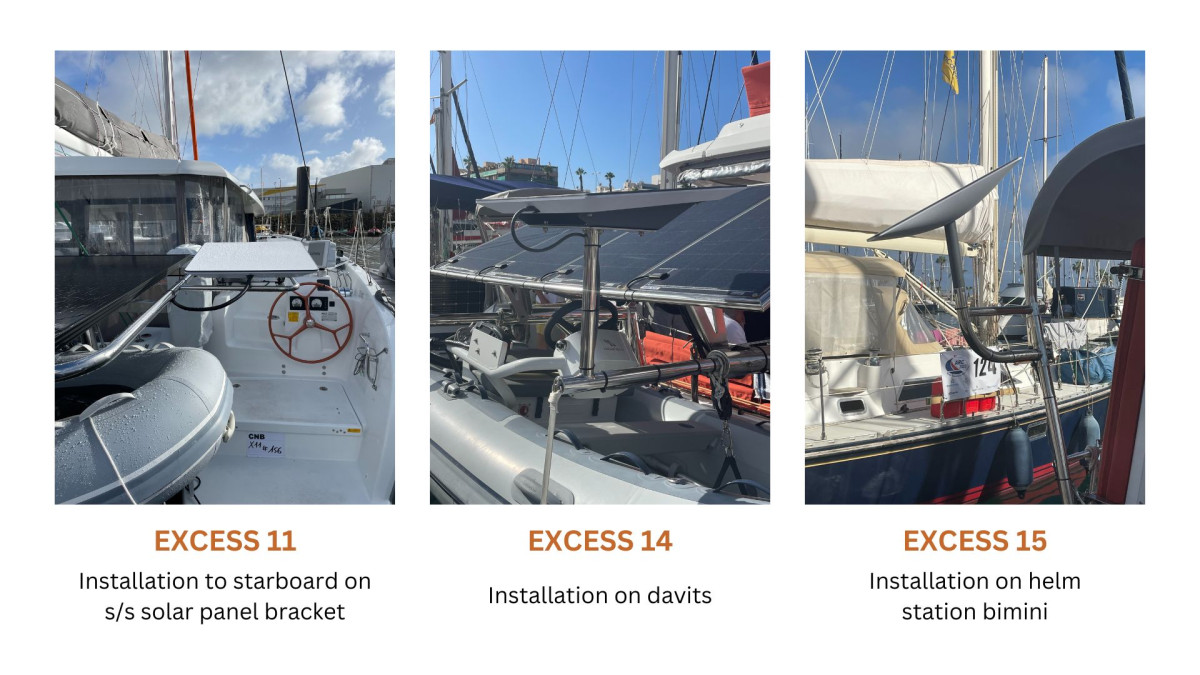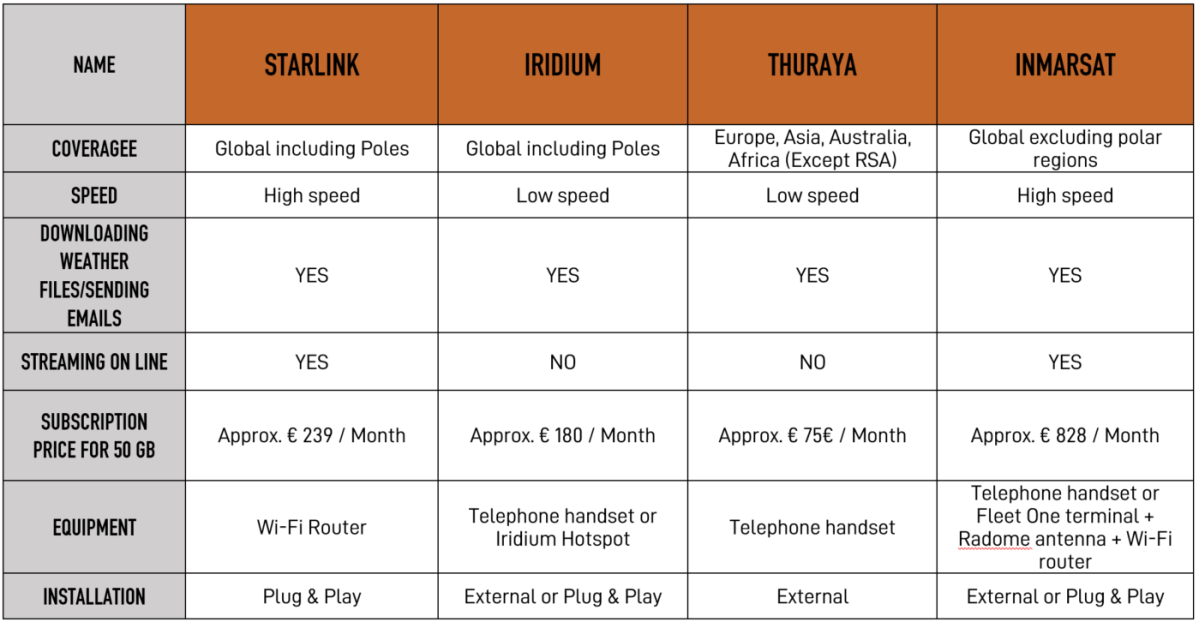GET YOUR CATAMARANS CONNECTED THANKS TO STARLINK

Sailing the seven seas has always been exciting, but it comes with its own set of challenges, not least connectivity on the high seas.
Starlink, the satellite network developed by Space X, opens up new possibilities by offering robust global connectivity, even in the most remote areas of the oceans.
1. High-speed Internet on the high seas: how does Starlink work?
The satellites communicate with each other via laser links to reduce dependence on ground stations, and signals are picked up by terminals with antennas (Starlink boxes).
On average, upload speeds are estimated at between 8 and 25 Mbps, and downlink speeds at between 40 and 220 Mbps. By way of comparison, the router in your home, connected via fiber optics, has an upload speed of around 180 Mbps and a download speed of 290 Mbps.
With a network currently comprising over 3,000 satellites, Starlink plans to deploy more than 12,000 by 2025, with a final target of over 30,000 to provide complete coverage.

2. How do I install Starlink on a catamaran?
Fitting a Starlink system aboard your catamaran is simple and effective: it is “Plug & Play”. Space X recently launched the Starlink Maritime option, and this is more resistant to ocean conditions and equipped with antenna, inclined bracket, cable, router and power supply.
The product itself is simply a flat rectangular antenna measuring 58 x 51 cm, connected by an electrical cable to a router and power supply.
For best installation, the antenna needs to be able to “see the sky”, meaning it must not be masked by the boom, shrouds or any other equipment found on a catamaran.
Note that this antenna must be powered by 220V or 110V on a US version. An inverter is therefore essential.
Excess owners typically choose to install the antenna on the bimini or aft of the transom.

3. What are the installation costs?
Purchasing the Starlink hardware is the responsibility of the boat owner. Space X’s sales channels are captive, and only the end-user can purchase the Internet box via the Starlink website.
To connect and install the system on board a catamaran, it will cost between €1,500 and €2,000 (excluding VAT) in 2024 to mount it on a stainless-steel bracket and run the cables to a new or existing 220v power supply.
4. What subscription options are available?
In 2024, three monthly subscription formulas are available:
- 50 GB: €239/month
- 1 TB: €940/month
- 5 TB: €4,713/month
For those with a home office on board and who live mainly on their boat, the 50 GB subscription will probably not be sufficient.
For a family of 4, Wi-Fi calls and SMS, streaming, TV, etc. represent an average consumption of 400 GB per month. You’ll need to take out the 1TB subscription to more than such cover needs.
That being said, most of the owners we interviewed who don’t spend 365 days a year on their catamarans tell us that the 50 GB offer is more than enough. What’s more, for those who don’t sail continuously or at regular intervals, it’s possible to activate or deactivate the subscription at any time. Once installed, an iOS or Android app lets you take control of Starlink via Wi-fi and benefit from broadband on board.
5. Other solutions for connecting to the Internet?
Starlink is not the only connectivity solution available on the market.
For coastal cruising, 3G/4G/5G networks, plus the many Wi-Fi equipped marinas, will more than meet your crew’s needs.
For offshore sailing, the most common are satellite operators, and there are 3 competitors to Starlink: IRIDIUM, THURAYA and INMARSAT.
Below is a table summarizing the differences between these providers:

6. Conclusion
One can therefore conclude that Starlink offers an innovative, easily accessible proposition in a market where other operators also offer solutions. It’s up to each individual to choose the offer best suited to their individual boating type and region.




Thank you for commenting on this article Rob, could you please tell us which monthly subscription you chose and what your average data consumption was?
[FRENCH]
Merci d'avoir commenté cet article Rob, pourriez-vous nous dire quel abonnement mensuel avez-vous choisis et quelle a été votre consommation de data en moyenne s'il vous plait ?
The possibilities are becoming endless and in the end we will be able to facilitate the always connected yacht. If we want to is a other discusion of course! :)
Home automation and control for boats including always updated weather info and chart updates. Not even speaking of the proactive security possibilities and proactive maintenance you can schedule for the next harbor based on IOT sensors. All the data (big data) you can getter as a catamaran builder. learn while sailing! Quick whatsapp call to the people at home. It's all possible.
A couple of months ago my company Blue Ocean Experience had our first business customer onboard that needed to do a virtual meeting during the day. We do day charters and bring sailing, business and adventure together on our first Excess 11.
This customer wanted to do a management meeting with his team to discuss and celebrate the fact they sold the software company to a US based company. In the afternoon they planned a town hall meeting (company wide meeting) with the new US colleges in the US. We delivered a perfect MS Teams session with the use of StarLink while sailing the Dutch inland waters. Customer happy, we happy. How cool?! Who needs a grey old meeting room when you can do it on a Excess 11?! (They were with eight guests).
Something to consider: Most liveaboards that want to have internet connectivity onboard have a combination of 3/4/5G LTE, StarLink and public WIFI. With the newest routers you can set this up to fall back automatically so you can have a good connection that is also cost efficient.
We will need time to adapt though. It was weird to look at social media while being offshore, some of what we try to find on the ocean - meditation, bounding with nature can easily be lost. The Greeks used to say that there are 3 kind of people : the living, the dead and the sailors. With Starlink sailors as a different species will disappear : sailors were person willing to spend long periods without contact with the rest of their tribes or families.
So it's up to us know to define, for each of us, how much we want to use it and when we want to turn it off so we can live a proper experience of immersing ourselves in nature, not just taking a picture of it to post on Instagram...
Bonjour Skiboo et merci pour votre commentaire !
Les zones d'abonnement sont principalement liées à des solutions autres que Starlink. On choisit alors des zones restreintes comme des pays, continents etc...où la réception et l'émission de données seront possibles. Le principe est un peu le même que l'abonnement des cartes marines sur certains systèmes de navigation.
Concernant le "roaming", il s'agit du fait d'utiliser le téléphone portable comme point d'accès internet en dehors de son propre réseau national, généralement dans un autre pays. Lorsque vous voyagez à l'étranger, votre téléphone se connecte à un réseau appartenant à un opérateur local, ce qui vous permet de passer et recevoir des appels, d'envoyer des messages texte et d'utiliser des données. Cependant, l'utilisation du roaming peut entraîner des frais supplémentaires, car votre opérateur de téléphonie mobile peut vous facturer des tarifs spéciaux pour l'utilisation de son service à l'étranger. Attention notamment si vous changez de continent, la facture peut vite devenir salée.
[ENGLISH]
Hello Skiboo and thank you for your comment!
Subscription zones are mainly linked to solutions other than Starlink. You choose restricted zones such as countries, continents, etc., where you can receive and transmit data. The principle is much the same as that of subscribing to nautical charts on certain navigation systems.
Concerning "roaming", this means using your cell phone as an Internet access point outside your own national network, usually in another country. When you travel abroad, your phone connects to a network belonging to a local operator, enabling you to make and receive calls, send text messages and use data. However, roaming may entail additional costs, as your mobile operator may charge you special rates for using its service abroad. Particularly if you're moving to another continent, the bill can quickly become very high.